
Protecting your horse from infectious diseases can be challenging, but horse owners and farm managers can work together to reduce the risk and frequency of disease. A horse owner or farm/stable owner can take several precautions to help prevent introduction or control spread of diseases on a farm, says Dr. Josie Traub-Dargatz, a professor emeritus at Colorado State University’s College of Veterinary Medicine and Biomedical Sciences, in Fort Collins.
“When a farm or stable has a mobile horse population, it is difficult to completely eliminate introduction of disease agents,” Traub-Dargatz says. “It’s important, however, to reduce the risks for exposure.” In many cases of contagious equine diseases, direct contact with other horses poses the greatest risk. This can happen if you or one of your boarders takes a horse to a show, where horses are stabled closely or touch noses, or even on the farm across the fence from neighboring horses. One of the greatest risks, however, comes when a new horse comes to the farm because he has been in contact with a completely different group of horses.
There’s a difference between infectious disease and contagious disease. “Infectious disease may be caused by a virus, bacterium, parasite, fungus, etc., but it may not be contagious,” says Traub-Dargatz. “For instance, West Nile virus is not contagious horse to horse, but strangles or influenza is. For contagious disease, direct contact poses the biggest risk.”
What Poses a Biosecurity Threat?
Horses on adjoining properties often socialize over the fence. Some operations might have a buffer zone—a double fence between properties, with a lane between to prevent the horses from making direct contact. “If horses are socializing across the fence, you and your neighbor should agree on a preventative medicine plan … for disease prevention,” Traub-Dargatz says. Even a horse coughing nearby but without direct contact could spread disease to another animal.
A paddock next to a public road, trail, or bridle path could also be a concern. Be sure your horses can’t touch other horses that might be ridden by their paddock.
Water sources can be an issue if horses drink from a pond or ditch shared by neighboring horses, livestock, or wildlife. Some diseases like leptospirosis and salmonella can be spread this way between different species. Since you don’t always know what might be upstream from where your horse is drinking, it is safer to have horses drink from a waterer or tank where you have more control over the source.
Humans can also pose a biosecurity threat because they can unknowingly carry pathogens from one horse to another. Ideally, if owners, employees, or visitors have come from another barn, they should wash their hands and change to clean clothes and footwear.
Disease Control and Prevention
Vaccination is an important part of an infection control plan to prevent disease in a group of horses if they get exposed to a disease agent. “This is a critical aspect of controlling infectious diseases because in many instances we can’t completely prevent exposure,” says Traub-Dargatz.
Regarding contagious disease, however, the most practical aspect of control is physical separation of horses. A new horse should be quarantined for two to three weeks as far away from other horses as possible, and taking temperatures of all horses during this time is advisable. “For some diseases, if horses share air space they can be exposed,” says Traub-Dargatz. “Influenza … can be spread to other horses within 150 feet. That’s at least 10 stalls away.” Strangles, however, is more likely to be transmitted through physical contact or shared objects or water source, but it is always safest to move the infected horse(s) to another area of the farm where they won’t share the same air space with horses, she adds.
Additionally, if the sick horse is in a separate barn, this can serve as a reminder for workers to wash their hands and change clothes and footwear before entering the barn with healthy horses.
Take-Home Message
If possible, have an area to house new horses, preferably near the entrance to your property so they are less likely to make contact or share air space with your other horses. “This isn’t practical for horses coming back from a show or trail ride, but people need to accept the fact that there’s some risk in taking horses off the farm but monitoring these returning horses for signs of infectious disease by taking temperatures and monitoring for signs such as a cough, nasal discharge or other signs of illness can allow for early detection and intervention to limit spread of disease agent(s),” says Traub-Dargatz.
Ultimately, prevention and noticing a sick horse quickly is the best way to protect your herd. “How far a disease might get in your herd could be much less if you can take action quickly if you detect illness in the first horse to get sick,” Traub-Dargatz adds.


